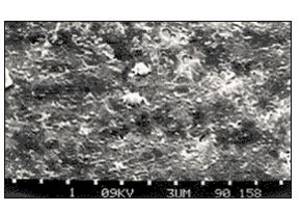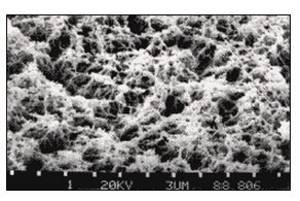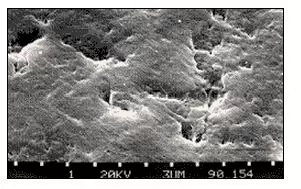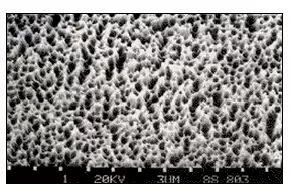Etsning
Plasmaetsning
Plasmaetsning är materialavlägsnande av ytor genom plasmaprocesser. Det kallas också torretsning, eftersom konventionella etsningsprocesser utförs med våtkemiska frätande syror. Processgasernas plasma omvandlar materialet som ska etsas från den fasta fasen till den gasformiga fasen och vakuumpumpen extraherar de gasformiga produkterna. Användningen av masker kan också säkerställa etsning av endast delar av ytan eller strukturerna. Plasmaetsning utförs endast som lågtrycksplasma p.g.a.
- Betydande etsningseffekter kräver längre behandlingstider.
- Nästan alla etsgaser kan användas i lågtrycksplasma.
Det finns en mängd olika applikationer för plasmaetsning. För applikationsspecifik optimering av etsningsprocessen finns en mängd möjliga processgaser och valet av 3 grundläggande etningsmetoder tillgängliga.
Jon-etsning
Beroende på applikation, även kallad ”fysisk etsning”, ”sputtering” eller ”mikrosandblästring”.
Argon eller andra ädelgaser som bildar joner men inga radikaler används som processgaser. Etsningseffekten är baserad på att atomer eller molekyler slås ut från substratet genom den kinetiska energin hos elektronerna som accelereras i det elektriska fältet.
Applikationer:
- Mikrostrukturering av ytor t.ex. för förbättring av vidhäftningen (”mikrosandblästring”)
- Bombardering av en ångavsättningskälla (”sputtering”)
Eftersom jonetsning inte har en kemisk effekt fungerar den på nästan alla substrat (praktiskt taget icke-selektiva). Etsningseffekten av plasma verkar nästan uteslutande i jonernas accelerationsriktning. Effekten är mycket anisotropisk.
Kemisk plasmaetsning
Processgaser används vars molekyler i plasman till största delen bryts ner till radikaler. Etsningseffekten är huvudsakligen baserad på reaktionen av dessa radikaler med atomerna eller molekylerna i substratet och deras omvandling till gasformiga nedbrytningsprodukter.
Primära applikationer:
- Nedbrytning av oxidskikt
- Borttagning av fotoresist (”stripping”)
- Askning av matriser för analys
- Etsning av PTFE
- Strukturering och mikrostrukturering av halvledare
Plasmaetsning är mycket selektiv, dvs processgaser och substrat måste matcha perfekt. Etsningseffekten är isotrop, dvs har samma effekt på alla sidor.
Reaktiv jonetsning
I plasman bildar molekylära gaser radikaler och positivt laddade joner. För etsning kan den reaktiva effekten av radikalerna samt jonernas kinetiska energi användas, om plasmaexcitationen sker genom att accelerera jonerna i det elektriska fältet och använda dem för att bombardera substratet.
Reaktiv jonetsning kombinerar effekterna av jonetsning och plasmaetsning: Det finns en viss anisotropi och material etsas som inte reagerar kemiskt med radikalerna. Framför allt ökar dock etsningshastigheten avsevärt. Genom att bombardera med joner försätts substratmolekylerna i ett exciterat tillstånd vilket gör dem mycket mer reaktiva.
Applikation:
- Främst vid etsning av halvledare
PTFE-etsning
Med Diener Electronicsa plasmateknik kan plaster göras limbara som anses vara ”icke limbara” på grund av sin låga ytenergi. Med polypropen (PP), polyeten (PE) eller polyoximetylen (POM) uppnås detta genom aktivering i syreplasman. För PTFE, plastmaterialet med minst ytenergi, är aktiveringsprocessen inte tillräcklig för att uppnå önskat resultat. Fluorkolbindningarna kan inte brytas i syreplasma.
I väteplasma kombineras emellertid väteradikaler med fluoratomerna i PTFE och bryter därmed kolbindningarna. Vätefluoridgasen utvinns och omättade kolföreningar kvarstår som polära vätskemolekyler kan fästa utmärkt vid.
En brunaktig missfärgning på PTFE-ytan visar att etsning har skett.
|






